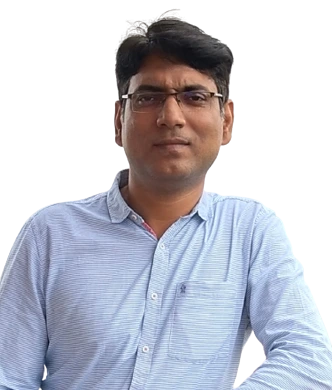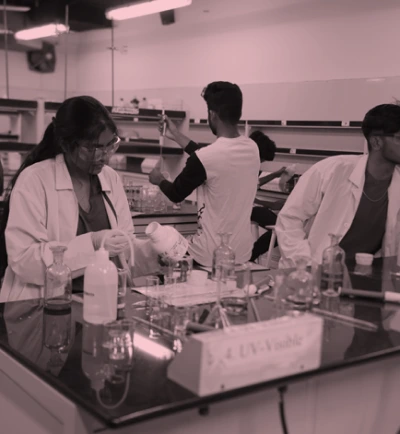
Jai Prakash
Associate Professor
jai.prakash@mahindrauniversity.edu.in
Dr. Jai Prakash is an Associate Professor in the Department of Mathematics at Mahindra University École Centrale School of Engineering, Hyderabad. He received his B.Sc. degree from Ewing Christian College, Prayagraj in 2002 and completed M.Sc. in Mathematics from Banaras Hindu University, Varanasi in 2004. He earned his Ph.D. from Indian Institute of Technology Kharagpur in the year 2010. Dr. Prakash’s research interests lie broadly in the area of Fluid Mechanics in particular flow through porous media, Mathematical Modelling.
2010
Ph.D. in Mathematics Indian Institute of Technology Kharagpur Kharagpur-721302, India
Dissertation Topic: Hydrodynamics and Intraparticle Nutrient Transport Inside Porous Pellets.
2004
Master of Science (M.Sc.) in Mathematics, 78.20% Banaras Hindu University Varanasi-221005, India
2002
Bachelor of Science (B.Sc.) in Physics and Mathematics, 71.05% University of Allahabad Allahabad-211002, India
2019- Present
August 2019- Present, Associate Professor – Mahindra University, Hyderabad.
2017
June 2017- Visiting Professor, Ecole Centrale Paris.
2014
July 2014 – Present Assistant Professor – Mahindra Ecole Centrale, Hyderabad.
2011-2014
Oct. 2011- July 2014 Post Doctoral Fellow – Department of Chemical Engineering Technion- Israel Institute of Technology, Israel
2011
Jan. 2011- Sep. 2011 NBHM Post Doctoral Fellow Department of Mathematics, IIT Kharagpur
2010
Sep. 2010- Nov. 2010 Worked in a CSIR project titled “Singularity methods for Stokes flow in presence of planar interface “.
2006-2009
2006-2009 Teaching Assistant for B.Tech. First Year (5 Semesters)
2021
- Jai Prakash, C. Satyanarayana, Axisymmetric Slow Motion of a Porous Spherical Particle in a Viscous Fluid Using Time Fractional Navier–Stokes Equation, Colloids Interfaces 2021, 5(2), 24.
2020
- Jai Prakash, Hydrodynamic mobility of a porous spherical particle with variable permeability in a spherical cavity, Microsystem Technologies, 26 (2020), 2601-2614.
2019
- Jai Prakash, G. P. Raja Sekhar, Effective viscosity of a concentrated suspension of composite porous spherical particles, Meccanica, 54, 799-813, (2019).
2017
- Jai Prakash, G. P. Raja Sekhar, Slow motion of a porous spherical particle with a rigid core in a spherical fluid cavity, Meccanica, 52, 92-105, (2017).
2016
- Olga M. Lavrenteva,Jai Prakash, Avinoam Nir, Effect of added mass on the interaction of bubbles in a low Reynolds number shear flow, Physical Review E, 93, 023105, (2016).
2014
- Jai Prakash, Olga M. Lavrenteva, & Avinoam Nir, Application of Clebsch variables to fluid-body interaction in presence of non-uniform vorticity, Physics of Fluids, 26 (2014), 077102.
2013
- Jai Prakash, Olga M. Lavrenteva, & Avinoam Nir, Interaction of bubbles in inviscid and low viscosity shear flow, Physical Review E, 88 (2013), 023021.
- Jai Prakash, Olga M. Lavrenteva, Leonid Byk, & Avinoam Nir, Interaction of equal size bubbles in shear flow, Physical Review E, 87 (2013), 043002.
- Jai Prakash, G. P. Raja Sekhar, Dynamic permeability of an assemblage of soft spherical particles, Mathematical Methods in the Applied Sciences, 36 (2013), 2174-2186.
- Jai Prakash, G. P. Raja Sekhar, Estimation of dynamic permeability of an assembly of permeable spherical porous particles using the cell model, Journal of Engineering Mathematics, 80 (2013), 63-73.
2012
- Jai Prakash, G. P. Raja Sekhar, Arbitrary oscillatory Stokes flow past a porous sphere using Brinkman model, Meccanica, 47 (2012), 1079-1095.
- Jai Prakash, G. P. Raja Sekhar, Mirela Kohr, Fax'en's law for arbitrary oscillatory Stokes flow past a porous sphere, Archives of Mechanics, 64 (2012), 41-63.
2011
- Jai Prakash, G. P. Raja Sekhar, Sirshendu De, Convection-diffusion-reaction inside a permeable cylindrical porous pellet under oscillatory flow - the effect of Robin boundary condition, International Journal of Advances in Engineering Sciences and Applied Mathematics, 3(2011), 60-70.
- Jai Prakash, G. P. Raja Sekhar, Mirela Kohr, Stokes flow of an assemblage of porous particles -stress jump condition, ZAMP, 62(2011), 1027-1046.
- Jai Prakash, G. P. Raja Sekhar, Sirshendu De, Dirichlet problem for convection-diffusion-reaction inside a permeable cylindrical porous pellet, International Journal of Engineering Science, 49 (2011), 606-624.
- Jai Prakash, Sirshendu De, G. P. Raja Sekhar, Convection-diffusion-reaction inside a porous sphere under oscillatory flow including external mass transfer, Fluid Dynamics Research, 43 (2011), 015508.
- Jai Prakash, G. P. Raja Sekhar, Overall bed permeability for flow through beds of permeable porous particles using effective medium modelstress jump condition, Chemical Engineering Communications, 198 (2011), 85-101.
2010
- Jai Prakash, G. P. Raja Sekhar, Sirshendu De, Michael B'ohm, Convection, diffusion and reaction inside a spherical porous pellet in presence of oscillatory flow, European Journal of Mechanics B/ Fluids, 29 (2010), 483-493.
- Jai Prakash, G. P. Raja Sekhar, Sirshendu De, Michael B'ohm, A criterion to avoid starvation zones for convection-diffusion-reaction problem inside a porous biological pellet under oscillatory flow, International Journal of Engineering Science, 48 (2010), 693-707.
2009
- Mirela Kohr,Jai Prakash, G. P. Raja Sekhar, and Wolfgang L Wendland, Expansions at small Reynolds numbers for the flow past a porous circular cylinder, Applicable Analysis, 88 (2009), 1093-1114.
- G. P. Raja Sekhar,Jai Prakash, and Mirela Kohr, Steady and oscillatory analysis of porous catalysts in fluidized beds, PAMM: Proc. Applied Mathematics and Mechanics, 8 (2009), 10613-10614.
Conference Papers:
2011
- Jai Prakash, Kamalesh Acharya, and G. P. Raja Sekhar, Reflection theorem for Stokes flow in presence of a partial-slip interface, Proceedings of ISTAM 2011, 175-184.
2006
- Jai Prakash, G. P. Raja Sekhar, Motility of a cell in viscous fluid flow, Proceedings of ISTAM 2006, 31-35.
Research Projects:
2018 – 2021, MTR/2017/000446, 12.07.2018, Hydrodynamics of Bubbles/ Drops/ Soft Particles in Porous Media- Volume Averaging Approach, INR 6,60,000, Science and Engineering Research Board (SERB), Govt. of India, funded under Mathematical Research Impact Centric Support (MATRICS), Jai Prakash, Department of Mathematics, Mahindra University.
Current Research:
- Motion of Bubbles and Drops:
The migration of small drops of one fluid through a second, immiscible fluid at small Reynolds numbers plays an important role in a variety of natural and industrial processes. Some of the examples are raindrop formation, the mechanics and rheology of emulsions, oil recovery. During the motion of a fluid drop in a second, immiscible fluid, the interfacial stresses acting at the drop surface tend to deform it. If the motion is sufficiently slow or the drop is sufficiently small, the drop will in the first approximation be spherical, but in case of dominant interfacial stress it is important to study the motion of deformed drop. It is general phenomena that rise in temperature reduces the surface tension which leads to migration of drops due to temperature, this phenomenon is termed as thermocapillary migration also the presence of any solute reduces the surface tension and this leads to migration of drops, this phenomenon is called as marangoni effect. It would be interesting to study the thermocappillary and marangoni effect on the deformed drops. - Development of Efficient Filter to Estimate Radioactive Release from Nuclear Power Plant (NPP) :
It is absolutely important to estimate the radioactivity release following an accident in a nuclear power plant due to its short and long-term impacts on the surrounding population and the environment. In case of any accidental release, a quick and reliable estimate is required to plan a rapid and effective emergency response and furthermore to design an appropriate evacuation strategy. The accurate prediction of incurred dose rate during normal or accident scenario is another important aspect. The Kalman-Filters can reduce the uncertainties in plume gamma dose estimation and release rate calculation. Three non-linear estimation techniques based on Kalman filtering namely, extended Kalman filter (EKF), unscented Kalman filter (UKF), and cubature Kalman filter (CKF) are proposed in order to estimate release activity and to improve the prediction of dose rates.
Awards
- PBC Post Doctoral Fellowship of Israel, 2012.
- NBHM Post Doctoral Fellowship (December, 2010).
- Senior Research Fellowship in Mathematical Sciences from Council of Scientific and Industrial Research (CSIR), India (August 2007-July 2010).
- Junior Research Fellowship in Mathematical Sciences from Council of Scientific and Industrial Research (CSIR), India (August 2005-July2007).
- Qualified Graduate Aptitude Test in Engineering (GATE) in Mathematics (2005) AIR-184.









